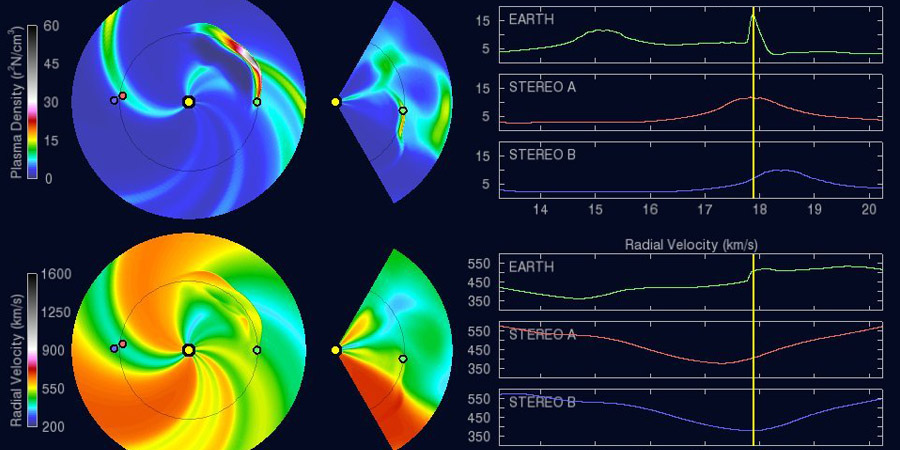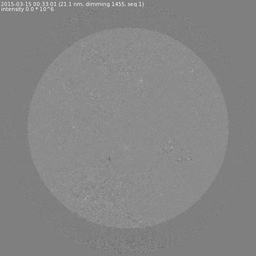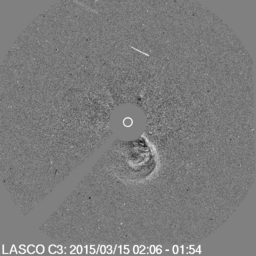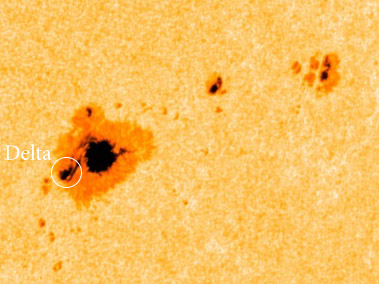C9 solar flare, sunspot region 2297, CME arrival?
Monday, 16 March 2015 16:16 UTC

A long duration C9 solar flare took place yesterday morning near sunspot region 2297 and launched a partial halo coronal mass ejection into space. While it is not a full halo coronal mass ejection, the coronal mass ejection was nonetheless very wide and caused an increase in the protons and electrons at Earth meaning that this coronal mass ejection will likely arrive at Earth. Based on the ejecta speed, the coronal mass ejection could arrive during the UTC evening hours of 17 March and cause a minor G1 geomagnetic storm.
Video: SDO footage of the C9 solar flare.

Animation: SDO difference imagery showing how eruptive the long duration C9 solar flare was.

Animation: SOHO LASCO C3 imagery showing the coronal mass ejection that was launched by the long duration C9 solar flare.
While the minor S1 solar radiation storm has not been reached yet following the C9 solar flare, we do need to remain alert as the minor S1 solar radiation storm threshold could still be reached when the coronal mass ejection from the C9 solar flare arrives.
Coronal mass ejection arrival?
This morning around 06:00 UTC we saw a small but notable increase in both the solar wind and IMF parameters which could signal the arrival of a coronal mass ejection. While unknown which coronal mass ejection is could be, it is likely a glancing blow coronal mass ejection passage from one of the many eruptions that sunspot region 2297 managed to produce over the past week. While this ''impact'' didn't really had any solid clues that it really is a coronal mass ejection passage, there were no coronal hole high speed streams expected to arrive at Earth.
Solar wind and IMF values remain above average at the time likely due to glancing blow CME effects but the IMF (Bz) is pointing north and this will prevent a lot of geomagnetic unrest. We could still reach active (Kp4) conditions tonight but it is vital that the direction of the IMF (Bz) turns south.
Sunspot region 2297
Sunspot region 2297 remains by far the most threatening sunspot region on the Earth-facing solar disk but it did decay significantly the past few days. There remains a prominent delta sunspot near the large trailing sunspot but overall, there has been a lot of decay and this has an effect on the likelyhood for another strong solar flare. X-class solar flares are a thing of the past but more M-class activity is not unlikely. We do need to note that sunspot region 2297 is now rotating towards the west limb and any future eruptions will at best only be partially Earth-directed. A significant eruption could still trigger a solar radiation storm at Earth.
M-class flare probability for the coming 24 hours: 40% chance
X-class flare probability for the coming 24 hours: 5% chance

Image: Sunspot region 2297 as seen by SDO. The delta structure has been highlighted with a circle.
Thank you for reading this article! Did you have any trouble with the technical terms used in this article? Our help section is the place to be where you can find in-depth articles, a FAQ and a list with common abbreviations. Still puzzled? Just post on our forum where we will help you the best we can!
Latest news
Latest forum messages
Support SpaceWeatherLive.com!
A lot of people come to SpaceWeatherLive to follow the Sun's activity or if there is aurora to be seen, but with more traffic comes higher server costs. Consider a donation if you enjoy SpaceWeatherLive so we can keep the website online!

Space weather facts
| Last X-flare | 2024/03/28 | X1.1 |
| Last M-flare | 2024/04/18 | M1.2 |
| Last geomagnetic storm | 2024/04/16 | Kp5 (G1) |
| Spotless days | |
|---|---|
| Last spotless day | 2022/06/08 |
| Monthly mean Sunspot Number | |
|---|---|
| March 2024 | 104.9 -19.8 |


